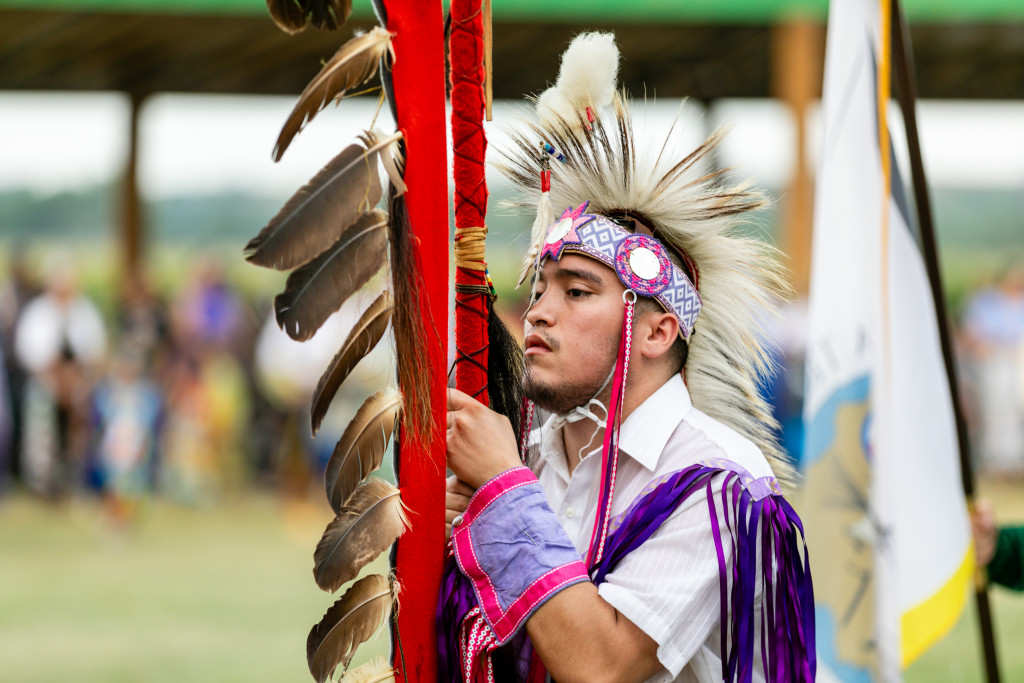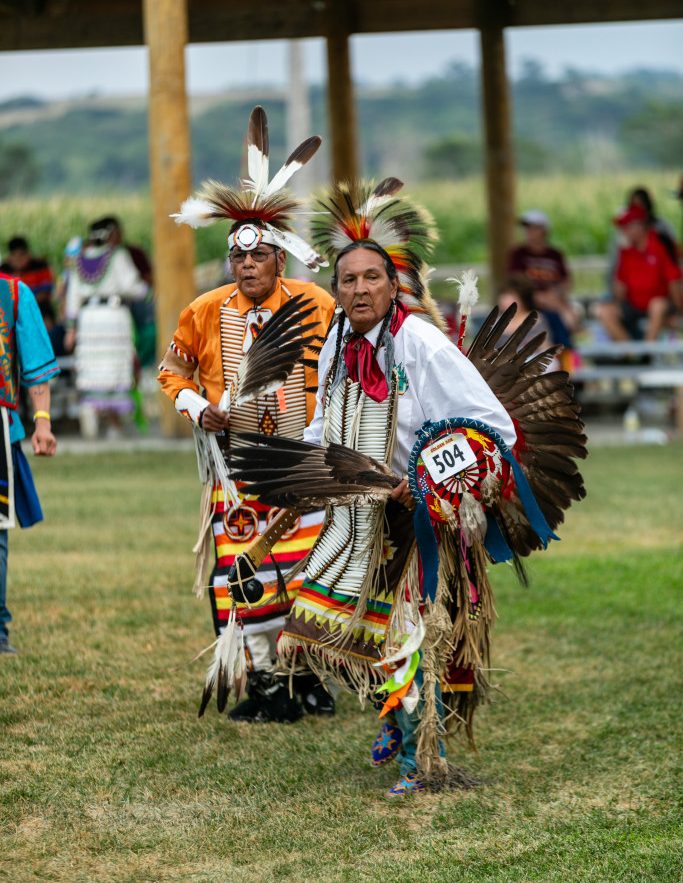
Story and photos by Jenny Nguyen-Wheatley
The 29th Annual Northern Ponca Tribe Powwow is Aug. 11-13, 2023, with grand entries — ceremonial entrances to the grounds by tribal dancers — at 7 p.m. Friday, 1 p.m. and 7 p.m. Saturday, and 1 p.m. Sunday. The powwow grounds are located 1 mile west of Niobrara on Highway 12: If coming from the east, turn left at the Ponca sign, located across Niobrara State Park, and follow the pavement.
All dancers and spectators are welcome. Ponca Culture Director Richard Wright Jr. shares insights on this sacred Native American tradition.
Q: What is the purpose of the powwow?
A: The powwow is about our people coming together with friends and family and practicing our culture, traditions and way of life. I think it’s especially significant with the Northern Ponca because we’re so spread out. It gives us an opportunity to come together and be one. We’ve been having this powwow since 1994, but there were powwows that took place prior to our termination [by the United States Congress] in 1962.
Powwow, itself, is relatively modern. You’re talking about the late 1800s to early 1900s. The word “powwow” actually comes from an Algonquian word “pau wau,” meaning “medicine man,” and it got interpreted later on by the early settlers as a gathering of some kind. So, we actually took that word back and made it our own.
Our traditional range in Nebraska goes all the way from Sioux City to the Black Hills and then down south to Lincoln —Lincoln was where we’d go to collect our salt. The Southern Ponca Tribe [whose ancestors were Nebraska Ponca people who were forcibly relocated to Indian Territory in present-day Oklahoma in the mid-1800s] has had a major impact on the powwow circuit itself, creating the straight dancers, the fancy dancers and grass dancers. The Ponca songs that were created have also had an impact — you’ll literally hear them all across the country at different powwows.

Q: If the powwow is a new tradition, what was the impetus for its creation?
A: This tradition started — a lot of it — due to the
boarding schools and the breaking up of families. Powwow was a time for us to come together.
Q: What are the main elements of a powwow?
A: Usually, we’ll start off the morning with a contest of some kind. This year, we’re doing archery, horseshoe and cornhole tournaments. There’s always contest, because we love to compete. We also do a walk/run for diabetes through our health department. There are powwows I’ve seen that have carnival rides, fireworks shows — I’ve seen a little bit of everything at different powwows.
And then we’ll usually go right into Grand Entry and do a flag song [equivalent to the national anthem], veteran’s song and prayer song. Next, we’ll go into intertribals [when all competitors and visitors are welcome to dance], and within that, each drum group will take turns doing different intertribal songs.
Our powwow is unique because we invite both southern and northern drum types — with the northern drum being a little higher pitched, and there’s a little bit of a different rhythm to its beat. Another significant thing about northern drums is that they set up on the outside of the arena around the circle, and the southern drums will set up in the center of the circle.
Then we have a break around 5 p.m. to stop and eat. Last year, we had a Ponca poet who read stories.
We’ll have a second grand entry around 7 o’ clock. During the evening, we also do specials and giveaways, especially to recognize our previous head staff. We’ll also sing honoring songs to relatives who passed away.

Q: What is the purpose of the Grand Entry?
A: The Grand Entry is what starts everything up. We line up in a certain fashion, depending on what kind of dancer you are and whether you are female or male. In front is the head man, and he’ll be carrying the Ponca eagle staff. Then we’ll have three veterans carrying flags: the Ponca flag, U.S. flag and POW flag. Following behind are the Ponca princesses, straight dancers, men’s traditional and grass dancers, and then women’s traditional, fancy shawl and jingle dress dancers.
Q: How is the head man chosen?
A: The head man is selected each year by our powwow committee. He has to be a Ponca member, and the committee looks to see who has given their heart out when they’re dancing.
It’s an honor to be a head man.
Q: What do you eat at meal times?
A: All of our meals include fry bread of some kind, and usually also wojapi, a berry mix that you dip the fry bread in. A lot of our foods are soup-based, including corn soup. And of course, we always have buffalo meat.

Q: What are the different types of dances?
A: There’s the men’s northern traditional. We still do that up here because many of our members are mixed, especially with the Lakota and Dakota. There’s the men’s fancy dance, which we don’t really have any members who dance that up here, but our southern relatives [in Oklahoma] host the Fancy Dance World Championships — you have to be really energetic and move a lot. They drop and do the splits in the end, and it’s really entertaining.
And then we have the men’s straight dancers, who are generally adorned with otter skin caps and an otter that goes down their backs. And we also have the grass dancers who are moving really fast, keeping up with that movement and imitating the grass blowing in the breeze.
Generally, women’s traditional and women’s fancy dancers are moving pretty quick, too. And there’s the women’s jingle dress dance, as well.
Q: How are dancers judged?
A: We do team dances, and it’s judged by individuals who are selected — generally they’re elders or people who really know the powwow scene, who have traveled to different powwows and have seen a lot of these dances at other places. They look for cadence and rhythm — do dancers stop right at the end of the beat? How do the dancers’ form look when they’re dancing together? The judges look for a lot of different things.
We also do a switch dance. That’s when the men dancers dress like women dancers, and the women dancers dress like men. It ends up being kind of comical. We also do the men’s fancy shawl dance, when the women dancers will go out to the side of the arena and select a guy to do the fancy shawl dance.
We do a potato dance, where teams of two balance a potato between their foreheads. And the MC will tell them: “You have to jump up and down now” or “turn around and do a spin” or “get on your knees.” It ends up being really fun.

Q: What is the significance of the circular set up of a powwow?
A: You’d see the circular set up at every powwow across the country. The only difference is that I’ve seen some tribes dance counterclockwise, whereas most will go clockwise. From my research, the Ponca used to do things counterclockwise, and so originally, we would’ve danced “backwards.” But we slowly changed that over time somewhere in the early 1900s, and we started dancing clockwise. I couldn’t tell you why they switched, to be honest, but the circular stage represents our belief that everything goes full circle. Everything is never-ending — keeps going.
There are also certain protocols with the arena. When you enter, you have to go all the way around and come back out in the same place. If your kids are playing in the circle, you have to put some money on the head drum — there’s a respect factor that’s involved. Your kids are not supposed to be playing inside the arena. That arena is sacred.
Q: Elders, especially, are given respect and reverence during powwow. What is the role of elders within the community?
A: Our elders are revered to the highest degree and treated with the utmost respect with everything we do. It’s ingrained in our way of life and a part of our culture. They’re the wisdom and knowledge keepers. They’re the ones we go to if we have questions about anything, because they generally will have an answer one way or another.

Q: How many people attend the Ponca Powwow?
A: Last year, 1,600 people — give or take — attended the powwow over the weekend. It was probably the largest turnout we ever had. I think COVID had a huge impact on that. I think people who were isolated were really wanting to get out and be together and have that human interaction, which is so vital and crucial to Native culture.
Q: Advice for new visitors?
A: I just encourage people to come. I think they’re going to have a great time participating in and witnessing our culture, eating great food and listening to good music. If you’ve never been to a powwow, you need to at least go to one before you kick the bucket. Our powwow is one of the greatest to attend because we’re really friendly to outsiders and guests. We have EMS and security on site. We have plenty of vendors every year. If you’ve never had an Indian taco, you have to come and try one.
For the latest on the Ponca Tribe of Nebraska, follow updates on social media at facebook.com/PoncaTribeOfNebraska/.
